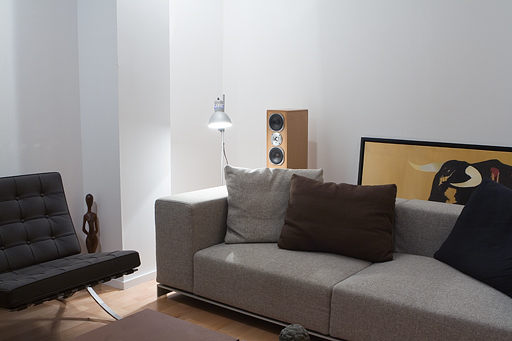This is an exercise I wanted to do time ago, but never found time and energies. This afternoon I did it, and although the result was not so good as I expected I wanted to start a discusion.
I wanted to compare the noise in a regular shot at base ISO100 vs an statistical averaging of several shots at higher ISO values. If the total exposure time was kept the same, the concept could be applied in a digital camera with a fast burst operation: the user clicks once, but the camera shoots several times in a quick sequence that will be averaged to improve noise. ISO is raised as needed to keep the total exposure time into the required shutter speed set by the user for the particular situation.
Please don't compare or think of applying this to present cameras, this is just a concept idea for fast burst cameras that could come in the future.
I shot the following scene with a Canon 350D on a tripod:
- First I shot it at ISO100, 2s
- Second I shot it 8 times at ISO800, 1/4s
The total exposure time was the same, 2s. Then I compared noise of the first shot (ISO100) vs two different statistical averaging of the other 8 shots: simple Average and Median. Surprisingly median was less effective in reducing individual impulsive hot/crazy pixels than simple average; that makes me think these hot pixels remain at the same locations in most of the 8 high ISO shots (I'll try a simple hot pixel elimination routine tomorrow).
There is a reduction in noise in the averaged images, but not spectacular at all. Anyway I think the concept can be interesting.
Images are B&W because I wanted to average undemosaiced data. I arbitrarily picked up the B channel of the RAW files and did the averaging without even clipping the black level in case Canon's non zero black level could mean an advantage in the end for this kind of noise reduction.
_________________
Application for HDR: the same idea of keeping more than one shot into one affordable total lapse of time, could be applied for in-camera HDR shooting.
Think of a landscape that has to be shot at 1/24 or faster because we are using a 24mm lens. The user sets shutter 1/24 but the camera could do two shots a couple of EV's apart: one at 1/30 plus one at 1/120. Total exposure time would be 1/30+1/120=1/24, enough to freeze our handheld shot at 24mm. The 1/30 shot would provide low noise in the shadows and 1/120 would provide the highlights. The blend would be automatically done by the camera without the user noticing. The 1/30 shot would only display a slightly higher noise in the shadows than a single shot at 1/24, nothing compared to the advantage of preserving 2 extra stops in the highlighs.
Regards.
 Helpful Posts: 0
Helpful Posts: 0
Results 1 to 5 of 5
-
27th October 2009, 11:26 PM #1

- Join Date
- May 2008
- Location
- Madrid (Spain)
- Posts
- 169
Burst + High ISO to improve noise
-
28th October 2009, 12:44 AM #2New Member

- Join Date
- Oct 2009
- Location
- Malmö, Sweden
- Posts
- 1
Re: Burst + High ISO to improve noise
Hi Guillermo & all...
I'm strongly favouring the combination of different exposures, as this tends to give you better real results than the averaging of several shorter exposures... In the multiple shorter exposures the ratio of natural light noise and the readout noise in the electronics in the camera get a bit skewed - read noise is lifted up further into the exposure, to the be lowered back to approximately the same level as the single exposure by the averaging effect.
The combining of two different exposures can give a very real and visible improvement of results in both the highlight and shadow regions... Even if you don't do any heavy HDR tonemapping. I do this quite often when the scene contains both darker static areas and brighter areas maybe containing moving objects like people or anything else. Shooting streetlife and architecture in strong direct sunlight is one of the activities that can benefit greatly from techniques like the one you outlined...
-
28th October 2009, 02:01 AM #3

- Join Date
- Dec 2008
- Location
- New Zealand
- Posts
- 17,660
- Real Name
- Have a guess :)
Re: Burst + High ISO to improve noise
I did this with 32 shots from a 20D at 3200 ISO - I combined them by changing the Photoshop layer opacity (100, 50, 33, 25, 20 etc) (in 4 batches if memory serves me correctly) - the resultant image looked equivalent to about ISO "150" (not as good as 100, better than 200).
Last edited by Colin Southern; 28th October 2009 at 04:17 AM.
-
28th October 2009, 03:28 AM #4
Re: Burst + High ISO to improve noise
This is close to the procedures employed by amateur and professional astronomers who use CCD imagers to combine a few to hundreds of exposures to reduce image noise.
Two image stacking programs that are well used, and free, are:
RegiStax
and
DeepSkyStacker
I recommend that you repeat your experiments using these packages to combine the frames.
-
22nd November 2009, 11:18 AM #5
Re: Burst + High ISO to improve noise
When I'm lazy, I just use multiple exposure on my D700. It works pretty darn well!






 Reply With Quote
Reply With Quote
